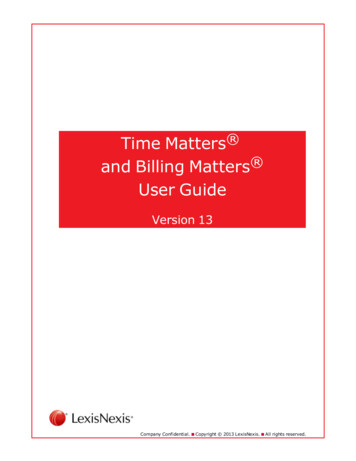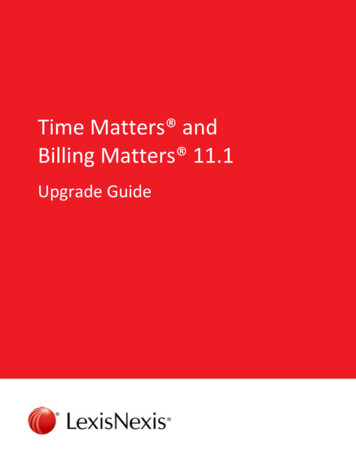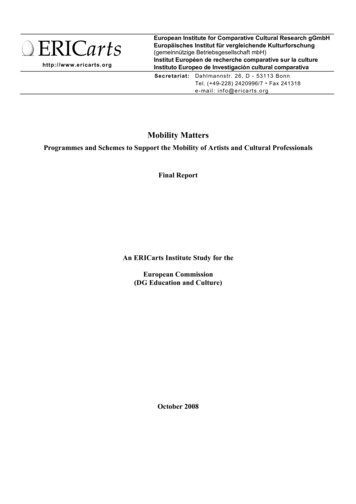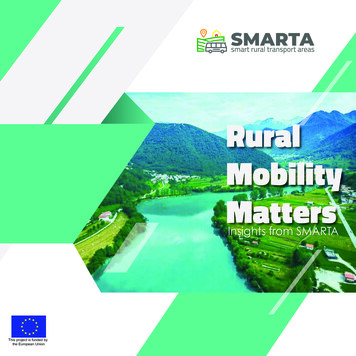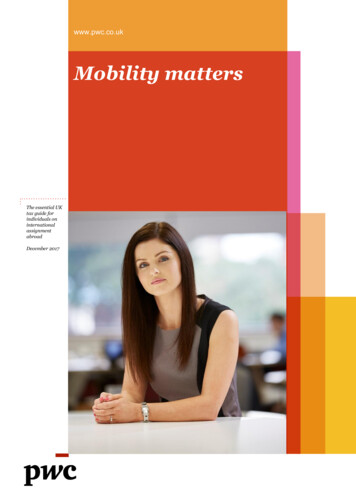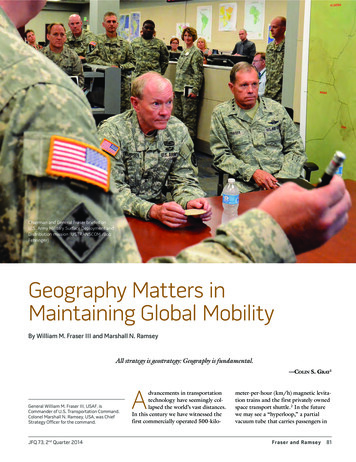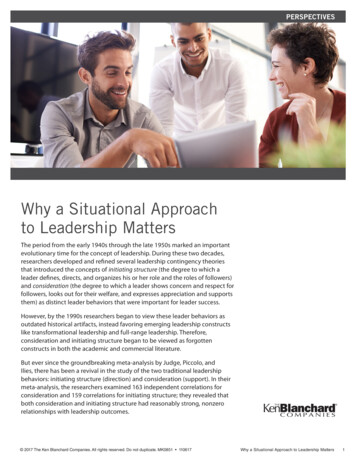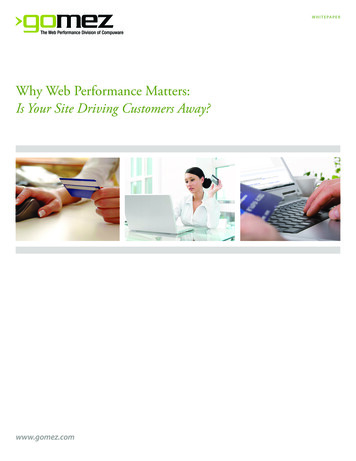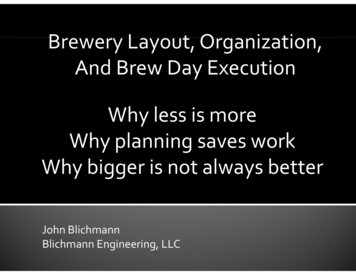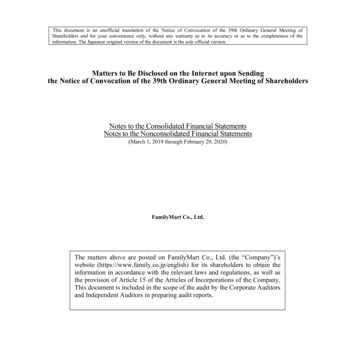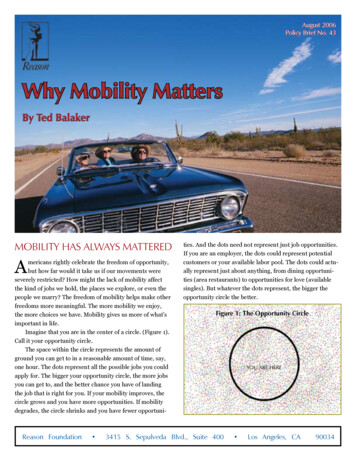
Transcription
August 2006Policy Brief No. 43Why Mobility MattersBy Ted BalakerMobility Has Always MatteredAmericans rightly celebrate the freedom of opportunity,but how far would it take us if our movements wereseverely restricted? How might the lack of mobility affectthe kind of jobs we hold, the places we explore, or even thepeople we marry? The freedom of mobility helps make otherfreedoms more meaningful. The more mobility we enjoy,the more choices we have. Mobility gives us more of what’simportant in life.Imagine that you are in the center of a circle. (Figure 1).Call it your opportunity circle.The space within the circle represents the amount ofground you can get to in a reasonable amount of time, say,one hour. The dots represent all the possible jobs you couldapply for. The bigger your opportunity circle, the more jobsyou can get to, and the better chance you have of landingthe job that is right for you. If your mobility improves, thecircle grows and you have more opportunities. If mobilitydegrades, the circle shrinks and you have fewer opportuni-Reason Foundation ties. And the dots need not represent just job opportunities.If you are an employer, the dots could represent potentialcustomers or your available labor pool. The dots could actually represent just about anything, from dining opportunities (area restaurants) to opportunities for love (availablesingles). But whatever the dots represent, the bigger theopportunity circle the better.Figure 1: The Opportunity Circle3415 S. Sepulveda Blvd., Suite 400YOu are Here Los Angeles, CA90034
yields. Mobility allowed them to break free from isolationand trade with others to improve their living standards.Improved mobility allowed people to multiply thebenefits of the division of labor. In the 18th century, economist Adam Smith observed that how much a society benefits from the division of labor depends upon “the extentof the market.” In other words, the more people a societycan trade with, the better off it will be. No doubt Smithwould smile at the extent of today’s markets. With eightmillion residents, New York is our nation’s largest city androughly 800 times the size of the cities of ancient Greece.Our agglomeration economies allow millions of people totravel within a metropolitan area to buy, sell, and play.When those within a metropolitan area are allowed to churnsmoothly, the economy reaches its potential. We can covermore ground faster and that means we enjoy opportunitycircles that are much larger than our ancestors had. Morejobseekers are able to find the right jobs. More businessesare able to attract more customers. More people enjoyhigher and higher living standards.We’ve come so far, but now something threatens to chipaway at our progress. The freedom that mobility gives us isgradually being taken away by congestion. It strangles dyna-Our ancestors had to make do with much smalleropportunity circles. Long ago they had only their feet to relyupon, and their feet couldn’t carry them far. (The averageperson can walk about four miles per hour.) But new modesof travel—wheeled carts, animal-powered carriages, trains,cars, and planes—allowed us to cover more ground faster.And opportunities expanded alongside these improvementsin mobility.Mobility has even helped us live longer. For hundredsof years, life expectancies hovered around 40 years; butduring the 1800s they began to shoot up and today lifeexpectancies in many advanced societies approach 80 years.What accounts for the dramatic increase in life spans?Harvard historian David Landes points to three factors:1. Better medicine2. Better disease prevention3. Better nutritionLandes notes that better nutrition “owed much to theincrease in food supply, even more to better, faster transport. Famines became rarer; diet became more varied andricher in animal protein” (emphasis added).1 Once thefate of townspeople rested on local food production, butimproved mobility gave them insurance against poor cropFigure 2: Life Expectancy801stLife expectancy (years)Pretransition2nd3rdTransition stage4th6958Sweden47England andWales3625150016001700180019002000Source: John Bongaarts and Rodolfo A. Bulatao, Eds. Beyond Six Billion: Forecasting the World’s Population (Washington, D.C.: NationalAcademies Press, 2000).WHY MOBILITY MATTERS2Reason Foundation
Figure 3: In Congestion for at Least 40 Hours AnnuallyCongestion in 2003Congestion in 1982SeattleMinneapolis -St. PaulSan FranciscoSacramentoSan JoseChicagoLos AngelesBostonNew YorkBaltimoreDCLouisville CharlotteDenverLos Angeles RiversideSan Diego paMiamiSource: Texas Transportation InstituteThe future looks bleaker still. Congestion in Los Angelesis legendary, but if our leaders continue to respond to themobility crisis with a shrug, many more areas will succumbto LA-style gridlock. By 2030, 11 additional urban areas(Chicago, Washington D.C., San Francisco, Atlanta, Miami,Denver, Seattle, Las Vegas, Minneapolis-St. Paul, Baltimore, Portland) will suffer through conditions as bad as orworse than present day Los Angeles.4 Eighteen other areas,from Phoenix to Orlando, will endure a level of congestionthat is only slightly less severe.Some of the costs of congestion are quite plain to see:stress, lost time, lost money from extra gas and wear andtear on automobiles. Other costs are less obvious. Congestion can be a problem even when we avoid it. Because gridlock is so unpredictable, we build buffer time into our travelplans. We give ourselves an hour to make a trip that wouldtake 30 minutes without congestion. Even if we manage toavoid congestion, we show up 30 minutes early and sit in aparking lot. Buffer time is wasted time and it adds up.Commuters recognize how congestion pesters us onour way to our current job, but what is less obvious is howit robs us of a wider variety of job options. We don’t evenconsider certain job opportunities because simply getting tothem (or even to an interview) is such a chore. We are lesslikely to seek out a better job and more likely to stick withthe less interesting, lower-paying one we already have. Likewise, congestion makes it harder for employers to attractthe best employees and harder for businesses to attract asmany customers as they could if travel were fast and pre-mism from our lives, our cities, and our nation. Some disagree. They argue that congestion is evidence of economicvitality. Yet clogged roads are evidence of economic vitalityonly in the same sad way clogged arteries are evidence ofnutrition.Clogged arteries sap life from even the strongest man.When blood flow slows, his speed of life slows. The activitiesthat once provided fulfillment, joy, and prosperity becomechores. The man gets winded from the slightest bit of activity. He reacts by doing less and less. He winds down.Many of our great cities are winding down, forcingtheir productive residents farther and farther away. Hereclogged streets sap the strength from the circulatory systemof urban life. When mobility slows, the speed of life slows.Eventually, the city simply does less and less.Congestion is more than 200 percent worse nationwidethan it was two decades ago.2 Now it smothers well-established areas (it’s up 183 percent in Washington, D.C.) aswell as upstart ones (up 475 percent in Atlanta).3 Not onlyhas congestion gotten much worse in areas where we expectit to be bad, it’s also making life increasingly sluggish acrossthe nation, from Portland to Austin to Charlotte.The average American now spends 47 hours a yearstuck in congestion—more than an entire work week—andit’s much worse in our big cities. In Los Angeles, the averagedriver spends 93 hours stranded on the roads. In 1983, onlyLos Angeles, had enough congestion to cause the averagedriver to spend more than 40 hours stuck in traffic. Just 20years later, 25 areas reached this threshold (Figure 3).Reason Foundation3WHY MOBILITY MATTERS
dictable.Congestion forces individual job seekers and businesses to pass up countless opportunities. Multiply theselost opportunities across an entire city and one can see howdegraded mobility siphons vitality from our great cities andhow it robs them of many of the benefits offered by agglomeration economies.Journalists often tout a supposed urban renaissance inwhich everyone, from singles to empty-nesters, is moving todowntown centers. While this may be true in some cases, itobscures the bigger picture: cities are losing influence.Since 1950, suburbia accounted for more than 90percent of the growth in our metropolitan areas.5 Cities likeBaltimore, Detroit, St. Louis, and Philadelphia continueto lose population; even foreign immigration cannot keepsome of our most celebrated urban centers growing. In thefirst half of the 2000s, Chicago, San Francisco, and BostonIf we ignore the mobility crisis our cities will continueto wind down and empty out .Individualslost population.The situation would be less dire if demographic trendssimply reflected the preference of Americans to live andwork in suburban environments. Indeed, the lure of suburbia has much to do with Americans’ preference for distinctlysuburban features, such as single-family homes, and manybusinesses see value in following all these potential workers to the suburbs. But often a suburban environment is notinherently superior for businesses. They would love to stayin the city and draw on all the energy offered by agglomeration economies, but they are forced out by degraded mobility and other urban headaches created by bad policy.U.S. Secretary of Transportation Norman Minetarecently referred to congestion as “one of the single largestthreats to our economic prosperity,” but most other leadersseem to be soothed by misleading tales of urban renaissance.6 Too many assume that our great cities can thriveeven as mobility degrades.We can no longer regard congestion as merely aneveryday irritant. Improving mobility is essential to ensuring our urban centers’ long-term survival. And if we ignorethe mobility crisis our cities will continue to wind down andempty out.It’s time to reassert the importance of mobility.Embracing the mobile society will improve life for individuals, for cities, and for our nation.We rarely contemplate the importance of mobility forthe same reason we rarely contemplate the importance ofoxygen. Mobility is so intertwined with our everyday livesthat it can be easy to forget how essential it is.A. Mobility Expands Employment OpportunitiesAs noted above, mobility expands our employmentopportunities. If it is difficult to get around, jobseekersmust limit themselves to the relatively small number of jobswithin their opportunity circle. And we don’t want just anyjob; we want the one that offers the best combination ofpersonal fulfillment and good pay. Maybe a jobseeker willfind the perfect job a couple of miles away from home, orbetter yet be able to telecommute; but chances are the perfect job exists farther away. At the turn of the 19th century,roughly 90 percent of the American workforce worked inthe same job category—farming. Other types of jobs wereavailable, but jobseekers had nowhere near the variety weenjoy today.Our economy offers countless occupations that werenot available to past generations. Today America is hometo 90,000 aerospace engineers, 337,000 fitness workers,832,000 software engineers, and many others who havethe kinds of jobs our great-grandparents could never haveimagined.7 Our ancestors often had to settle for jobs thatwere backbreaking and dull, but we can choose from a widearray of jobs that allow us to express ourselves creatively orthat allow us to make a living by doing good works. AmericaWhy Mobility Matters toWHY MOBILITY MATTERS4Reason Foundation
and that makes the kind of point-to-point travel offered bythe automobile particularly helpful. UCLA’s Evelyn Blumenberg discovered that residents in the Watts section of LosAngeles who can drive have access to 59 times as many jobsas their neighbors who rely on public transit.9Few things are better at helping the poor pull themselves out of poverty than improved mobility. Programsthat get cars to the poor—though relatively rare—haveshown strong success.10 Surveys of workers who receivedcars through such programs reveal that improved mobilitybrought them better jobs and higher wages, and a University of California, Berkeley study estimates that auto-ownership could cut the black-white unemployment gap nearly inhalf.11What about those of us who already own cars? We cangain greater wealth by improving mobility and reducingcongestion. Researchers at the Texas Transportation Insti-Reducing congestion would give residents access tomore and higher paying jobs.is home to 177,000 physical therapists and 626,000 counselors.In days gone by, workers weren’t expected to actuallylike their jobs, but today we have a better chance of mixingwork with personal fulfillment. That is, we have a betterchance if we can get to those jobs. Someone who enjoys ahigh level of mobility can choose from the full menu of jobopportunities. But without a high level of mobility we mustmake do with a smaller number of choices. That makes itless likely we’ll find a job that is fulfilling and pays well. Forfamilies with two earners, the chances of both finding fulfilling employment shrink as their opportunity circles shrink.More of us have been able to find jobs that put a roof overour heads and give our lives more meaning, but degradedmobility makes it harder for others to join the ranks ofthose who have escaped the live-to-work cycle.A lack of mobility is a key reason why the transitdependent poor have trouble moving up the economicladder. Although congestion makes auto travel increasinglysluggish, driving is still generally much faster than takingtransit. It takes the average transit user twice as long to getto work as the average car commuter.8 This is true even inthe New York metro area, where transit commuters endureour nation’s longest commutes (52 minutes each way). InChicago, the average transit commute is 50 minutes and it’smore than 45 minutes in San Francisco, Washington, D.C.,and Philadelphia.Most jobs are not clustered around a rail line or busroute. Rather, they are scattered throughout a metro areaReason Foundationtute estimate that congestion costs the average big-city resident about 1,000 each year in lost productivity and wastedgas. Recently two researchers looked at the other side ofthe issue: what would be the positive impact of improvingmobility by cutting congestion?Consultant Wendell Cox and Alan Pisarski, author ofthe seminal Commuting in America book series, analyzedthe Atlanta area and found that reducing congestion wouldgive residents access to more and higher paying jobs.12Cutting congestion in half would give each person an extra 1,750 per year. Come 2030, each household would get anextra 8,900. And what if congestion were nearly eliminated? What if it were cut by, say, 90 percent? That wouldgive each person 2,900 more each year. By 2030, thefigure would be 14,975 per household.13a lack of mobility is a keyreason why the transitdependent poor havetrouble moving upthe economicladder.5WHY MOBILITY MATTERS
If mobility fades, the dynamism of the city fades with it.B. Mobility and Personal Lifepoint of their opportunity circles. For parents, the state ofmobility helps determine how much time they will spendwith their children and how much time they will spendstranded on the road with strangers.Mobility even gives us more opportunity for romance.Our ancestors chose their mates from within a tiny geographic orbit for they had little opportunity to travel.Sometimes we do find the love of our life in our neighborhood, but often people find the “one” across town, acrossthe country or across the world. More mobility allows us tomix with more people and it gives us more opportunity tofind the person who’s right for us. Once we do find someoneto love, mobility makes it easier to add spontaneity to therelationship. We can surprise our significant other with aromantic dinner at a new restaurant or head to the lake fora stroll.The importance of mobility continues into every stageof life. Consider the search for the right house. If an areaoffers a high level of mobility, house hunters can choosefrom among a wide assortment of properties. Some maychoose to live close to work, but for others the situation ismore complicated. What happens when it’s time to changejobs? And since it’s unlikely that both work in the samearea, where should dual-income families live? Many families shape their travel patterns around other aspects ofWhy Mobility Matters toCitiesIf a city can draw on the effort and talents of morepeople, it will gain from the accumulated expertise of manypeople specializing in many different areas. As the divisionof labor expands, the city grows more prosperous. Yet thisexhilarating vision becomes reality only if the denizens of acity are able to mix freely and efficiently. A vast metropolishas the potential to draw on the effort and talent of millionsof people, but if mobility fades, the dynamism of the cityfades with it. The city becomes less of a grand metropolisand more of a collection of hamlets—hamlets whose residents are increasingly isolated from each other.A. Mobility Boosts ProsperityWhen mobility fades, employers are also hurt. The dragof congestion slows all kinds of businesses. Consider businesses that deliver things, from pizza to parcels. They areforced to pay workers for their unproductive time (whentheir lives, such as the children’s education. After all, publicschools, unlike jobs, are assigned on the basis of proximity.Parents carefully shop for a house located in a good schooldistrict and when they find one this becomes the centerWHY MOBILITY MATTERS6Reason Foundation
they’re stuck in traffic) and forced to pay extra for gas andmaintenance. Congestion slows businesses and decreasesthe number of customers they can serve. And because congestion is unpredictable, delivery schedules also grow moreerratic. Because of traffic congestion a Fort Lauderdale-areacement company discovered that it could no longer makereliable deliveries to construction sites during the week.14The company was forced to make Saturday deliveries andincur the extra expense of overtime pay. Often companiestry to pass the cost of congestion onto customers and thismakes many products, from food to furniture, more expensive than necessary. In other words, congestion can act asa hidden tax, making a wide range of goods and servicessomewhat more expensive.Congestion’s impact is not limited to delivery businesses. It’s felt by everyone from plumbers and landscapers to salespeople and realtors. Throughout the day theseSan Francisco. Members of the U.S. Chamber of Commerce rank it among their top concerns and in certain areasthe problem is particularly acute.18 A recent survey askedSilicon Valley CEOs about their most daunting businesschallenges.19 In the span of a single year, congestion movedfrom the number nine challenge to number two. Accordingto the executives, only the Bay Area’s extremely high housing costs posed a bigger threat, and congestion was listedahead of perennial business headaches like taxes, regulations, and health care costs.people try to reach as many customers as they can, butcongestion stands in their way.It’s easy to see how congestion would hurt the trucking businesses. Congestion forces independent contractorsto absorb the costs of extra time, gas, and wear and tear ontheir own. Trucking companies face additional frustrations.They figure out how much it will cost to haul something bycalculating how long it will take to get from point A to pointB. Yet there’s more to it than just distance. Simply contending with bottlenecks costs trucking companies an estimated 8 billion per year.15 Since congestion makes trips longer,companies are forced to pay for more drivers, trucks, andgas. And since
It’s time to reassert the importance of mobility. Embracing the mobile society will improve life for individu-als, for cities, and for our nation. wHy MoBiLity MAtteRS Reason Foundation. Reason Foundation wHy MoBiLity MAtteRS.

